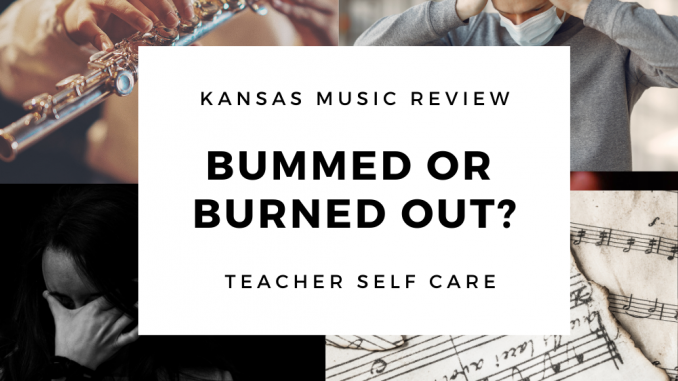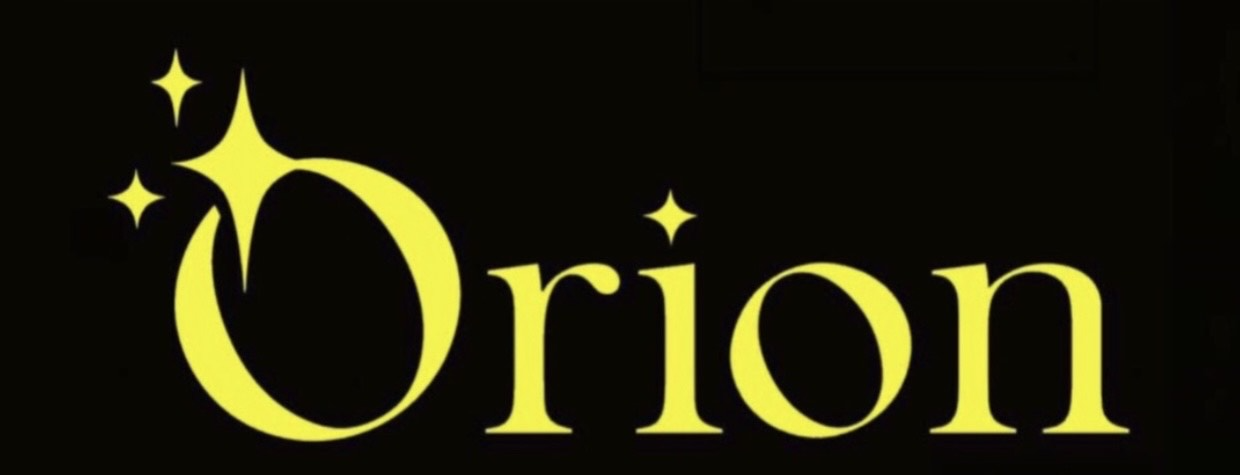
Diagnosis, and Remediation
By Paul Fox
Reprinted with permission from Paul Fox’s blog as featured in Music in a Minuet.
THIS IS PART VI IN A SERIES OF ARTICLES ON EDUCATOR HEALTH AND WELLNESS, FOLLOWING “STRESSED OUT!” AND “TEACHER SELF-CARE DURING THE PANDEMIC.”
Do you recognize these signs of burnout experienced by yourself, a coworker, neighbor, or someone you love?
- Physical: tired, lowered immunity, illnesses, aches and pains, loss of appetite or sleep
- Emotional: sense of self-doubt, failure, helplessness, loneliness, cynicism, loss of satisfaction/motivation
- Behavioral: withdrawal, isolation, skipping work, procrastination, frustration, overuse of food, drugs, alcohol
By the time it gets to that third bullet, probably everyone would be aware of the trouble.
You may be on the road to burnout if:
- Every day is a bad day.
- Caring about your work or home life seems like a total waste of energy.
- You’re exhausted all the time.
- The majority of your day is spent on tasks you find either mind-numbingly dull or overwhelming.
- You feel like nothing you do makes a difference or is appreciated.
— Burnout Prevention and Recovery by Melinda Smith, M.A., Jeanne Segal, Ph.D., and Lawrence Robinson
Gregory S. Perkins and Angela M. Guerriero, licensed Music Therapists from the Tempo! Music Therapy Services provided much more detailed definitions of self-care in a session at the PMEA 2020 Virtual Summer Conference. (PMEA members may continue to register and view a video of this workshop until mid-September 2020.) You should know and be on the lookout for these terms:
The United Nations defines self-care as the actions that individuals take in order to develop, protect, maintain, and improve their own health and well being. Self-care involves a personal investment in maintaining physical, psychological and spiritual health, and pursuing a fulfilling, well-rounded life.
Brownout: “A practitioner essentially gives up or performs in a perfunctory manner when confronted with too much stress and too little gratification.” Guy, J. & Norcross, J.(2007). Leaving it at the office: a guide to psychotherapist self-care. New York, NY: Guilford Publications, Inc.
Burnout: “A syndrome of physical exhaustion including a negative self-concept, negative job attitude, and loss of concern and feelings.” Keidel, G. (2002). Burnout and compassion fatigue among hospice caregivers. American Journal of Hospice and Palliative Care, 19(3), 200-205
The Mayo Clinic offers numerous symptoms of “burnout.” How many of these have you “felt” too or noticed in someone else’s demeanor or behavior?
- Disillusionment over the job
- Cynicism at work
- Impatience with co-workers, administrators, and students
- Lack of satisfaction in accomplishments
- Dragging yourself to work and trouble getting started once you’re there
- Lack of energy
- Unexplained aches/pains
- Self-medicating with food, drugs, or alcohol
- Changes in sleep/eating patterns
Education Week adds many more danger signs. Are any of these striking close to home?
Exhaustion. This is a fatigue so deep that there’s no way to “turn it off,” no matter how badly you want to. It’s deep in your bones. The kind of tired where you just want to ooze into your bed and disconnect from life.
Extreme graveness. Realizing you go hours without smiling or laughing, or days without a belly laugh.
Anxiety. The constant, nagging feeling that you can and should do more, while simultaneously realizing you need to unplug and spend more time with your family. But there are so many things to do.
Being overwhelmed. Questioning how they can possibly add one more task, expectation, or mandate to your plate. Compromising your values of excellence just so you can check-off 15 more boxes to stay in compliance. All the while knowing it still won’t be enough.
Seeking. Losing your creativity, imagination, patience, and enthusiasm for daily challenges. Craving reflection time and productive collaboration rather than group complaining.
Isolation. Wanting to head for the deepest, darkest cave where no one will see your vulnerability. A place where your limits are unseen and unquestioned and all is quiet.
— Six Signs of and Solutions for Teacher Burnout by Wendi Pillars
What about the causes of burnout or brownout? Where should we place the blame?
According to Paul Murphy in his book, Exhausted – Why Teachers Are So Tired and What They Can Do About It, the stress of a few problems may stand out as leading culprits at your place of employment:
- Lack of autonomy
- Dysfunctional work environment
- Inadequate social support
- Extremes of activity
- Poor work/life balance
But, you have no one else but yourself to blame! You must take responsibility for your own health and welfare. Most of the sources in this blog post (including a few mentioned in past articles from this “care” category) suggest solutions to better self-care, many of which offer answers to address the issue and CAN BE DONE RIGHT NOW.
Here are a few more self-care tips from PsychCentral:
- Create a “no” list, with things you know you don’t like or you no longer want to do. Examples might include: Not checking emails at night, not attending gatherings you don’t like, not answering your phone during lunch/dinner.
- Promote a nutritious, healthy diet.
- Get enough sleep. Adults usually need 7-8 hours of sleep each night.
- Exercise. In contrast to what many people think, exercise is as good for our emotional health as it is for our physical health. It increases serotonin levels, leading to improved mood and energy. In line with the self-care conditions, what’s important is that you choose a form of exercise that you like!
- Follow-up with medical care. It is not unusual to put off checkups or visits to the doctor.
- Use relaxation exercises and/or practice meditation. You can do these exercises at any time of the day.
- Spend enough time with your loved ones.
- Do at least one relaxing activity every day, whether it’s taking a walk or spending 30 minutes unwinding.
- Do at least one pleasurable activity every day; from going to the cinema, to cooking or meeting with friends.
- Look for opportunities to laugh!
— What Self-Care Is and What It Isn’t by Raphailia Michael, MA
We should also review “Five Tips for Avoiding Teacher Burnout” by Mary Beth Hertz, an Edutopia blog (read the entire article for greater depth and clarity):
- Maintain your “other” life.
- Be a stakeholder when changes are made.
- Find lessons and opportunities in everything.
- Nurture peer connections.
- Keep it light.
Edutopia, from the George Lucas Educational Foundation, is a wonderful resource. Most recently, three valuable “streams” of articles have been released on coping with the preparations and stress in the reopening of schools for the 2020-2021 year:
- “Teachers Around the World Tell Us Reopening Is Tough, but Joyful” and others
- “Teaching Through the Pandemic: A Mindset for This Moment” and others
- “Seven Takeaways from Our Experiences with Distance Learning” and others
I also recommend this blog-post of the Regional Education Laboratory Program which describes “teacher well-being” as “the reaction to the individual and collective physical, environmental, and social events that shape how educators respond to their students and colleagues.” They discuss how three prominent human behavior frameworks— Maslow’s Hierarchy of Needs, the Five Stages of Grief and Loss, and the Concerns-Based Adoption Model (CBAM)— can be used to address the challenges that teachers face when adapting to change and identify approaches to support teacher well being.
In addition, the following perspectives come from a variety of self-proclaimed practitioners:
“One of Leonardo da Vinci’s seven essential elements of genius is known as Sfumato, Italian for ‘smoked,’ or ‘going up in smoke.’ This principle is the ability to embrace uncertainty, the unknown, and the unknowable. In my interpretation, it’s also an ability to ‘let go’ of everything that’s left undone when you know you’ve done your best. Embrace Sfumato.” — Wendy Pillars
“Self-care needs to be something you actively plan, rather than something that just happens. It is an active choice and you must treat it as such.” — Raphailia Michael
“Remember that example about putting on your own oxygen mask before helping others? This is where that analogy really comes in to play. It’s time for you to take a good hard look at your self-care versus your care for others and decide if you are in a place where you have a good balance or if you need to make this a priority… Why is self-care… such a critical component of your physical and mental health? Because in order for you to function at your peak, you need to meet the needs your body and mind have for rejuvenation, relaxation, and rebirth. If you are constantly putting out efforts toward other people and events but never taking time to refuel yourself, then you will run out of steam and it will manifest in your body as an illness, weight gain, acne, joint pain – you know the drill – again.” — Lesley Moffat in I Love My Job But It’s Killing Me
“It’s estimated that teachers make about 1,500 decisions every school day. When you combine those decisions with all the necessary self-regulation involved with teaching kids, it’s no wonder our willpower is gone by five o’clock. We are exhausted.” — Paul Murphy
The term “unprecedented times” has become a hallmark for describing the context in which leaders must respond to changing needs during the COVID-19 pandemic. Effective responses in education are dependent upon teachers as the front-line workers in classrooms, so it’s essential that administrators take care of teachers. When they do so, they also take care of students.
When teachers don’t have the resources they need, and especially when sustained job demands are high, teachers experience chronic stress — and eventually burnout.
Teachers who are burned out are less effective as teachers, have less supportive relationships with students and, in turn, the students they teach have lower academic and social outcomes.
We should all read the above blog-post from The Conversation, which offers these conclusions based on a national Canadian education survey conducted in May 2020:
- Teachers’ concern for vulnerable students is one of the most stressful aspects of their jobs right now.
- Teachers are seeing magnified inequities.
- When giving teachers initial resources, less is more.
- Perceived support matters to teachers’ resiliency.
- Teachers are concerned about effectively engaging students through remote learning, and professional collaboration can help.
Finally, we’ll end this epistle on “things to do to avoid burnout” with a timely and practical article from Carlee Adams found on the We Are Teachers site: 15 Smart Ways to Prevent Teacher Burnout That Really Work. Repeating many of the suggestions above, these “find these” remedies resonated with me:
- “Find someone you can be vulnerable with…”
- “When you feel hopeless, find perspective…”
- “Find your own voice and allow it to change over time…”
- “Find your people; they get you!”
The bottom line? If you “feel” consistent periods of burnout, brownout, or being bummed out in your career as negative influences to your “calling” as a teacher, you cannot sit back and let things continue “as is!” Most professionals cannot self-diagnose this problem (but, perhaps a family member may clue you in!). If you notice that you are continually having trouble sleeping, difficulty with relationships or communicating your thoughts to others, or find yourself feeling significantly depressed or lethargic, it may be time to visit your health care professional.
© 2020 Paul K. Fox

About the Author: Paul K. Fox, a NAfME Retired Member, is Chair of the PMEA State Council for Teacher Training, Recruitment, and Retention. He invites you to peruse his website.























